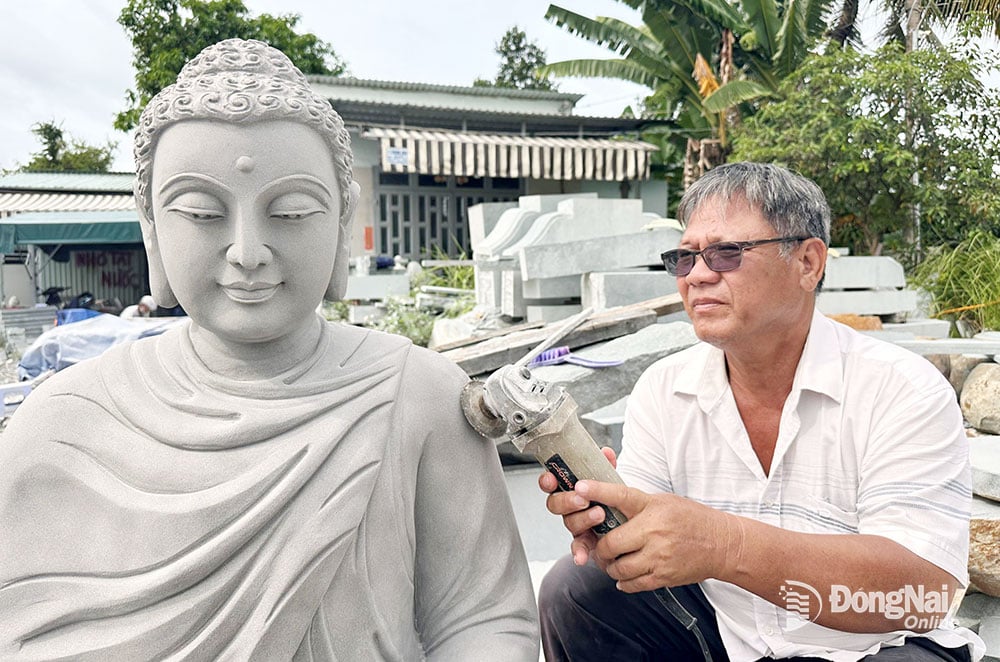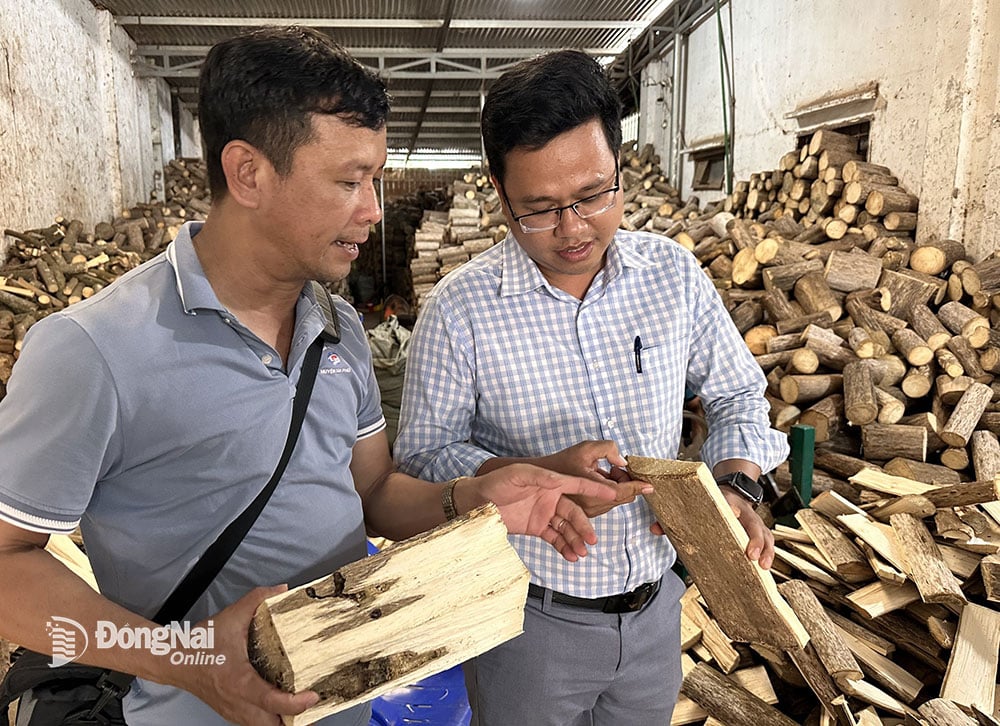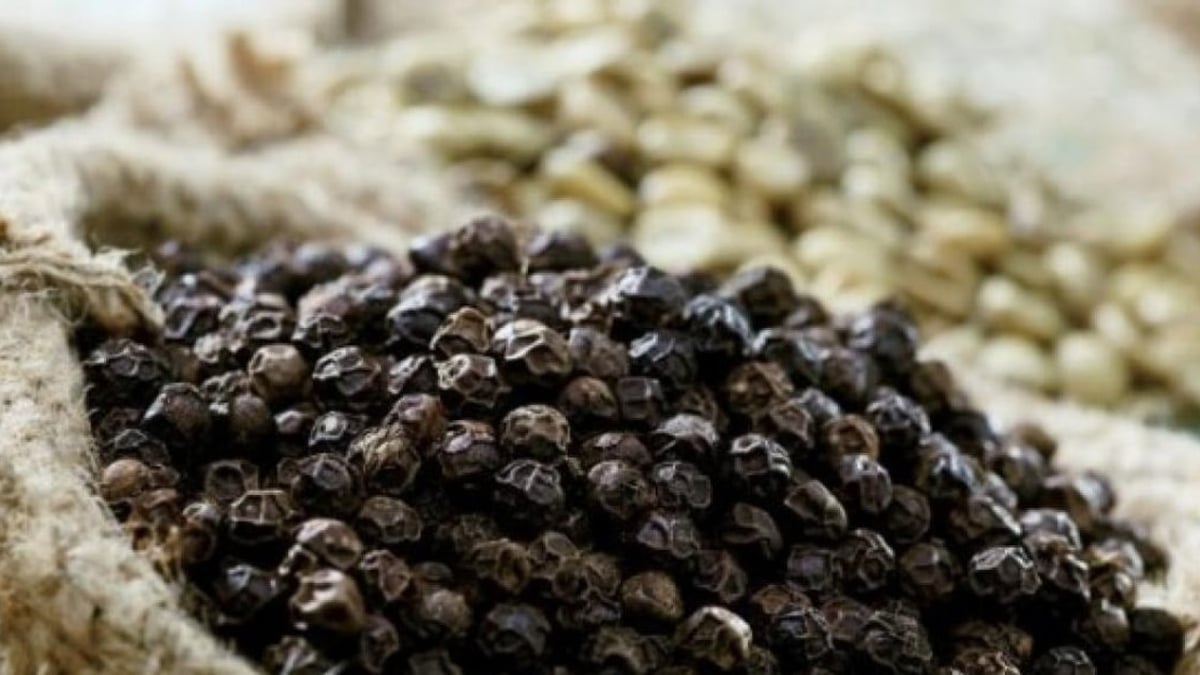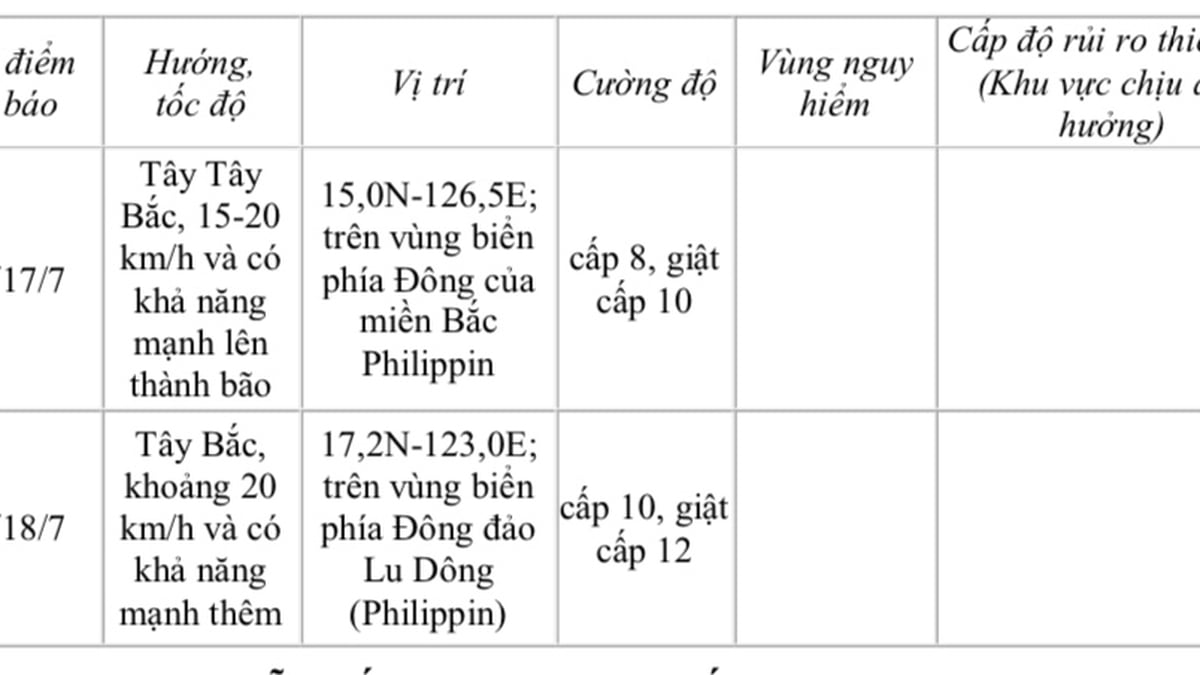Following the flow of history, Dong Nai has formed famous craft villages such as: Buu Long stone craft village, Tan Van pottery village (Bien Hoa city), Thanh Phu cast iron village (Vinh Cuu district), mushroom growing (Long Khanh city), agarwood (Tan Phu district), fine art wood (Trang Bom district, Xuan Loc district)...
 |
| Artisan Pham Duy Linh crafts products from green stone according to customers' orders. Photo: N. LIEN |
Traditional craft villages in Dong Nai were formed according to the development of each period, from ancient times to the second half of the 20th century and the beginning of the 21st century. Therefore, each craft village in Dong Nai contains stories with its own cultural identity, creating a Dong Nai convergence with rich and diverse cultural identities.
* Hundred-year-old craft villages
It is not strange to name famous and long-standing craft villages in Dong Nai such as: Buu Long stone craft village, Tan Van pottery village or Thanh Phu cast iron village. Because these are craft villages that were formed very early, during the land reclamation of immigrants to Dong Nai. These are craft villages that are hundreds of years old and still exist today even though they have passed their most prosperous period.
Buu Long stone craft village is one of the oldest craft villages in Dong Nai. Buu Long stone craft village is located along the Dong Nai River in Buu Long Ward (Bien Hoa City), more than 300 years old and was formed by the Chinese people of He State from China. Through many ups and downs of history, Buu Long stone craft village is still one of the famous craft villages in the country, contributing many architectural and artistic works throughout the country with sculptures made from green stone, a type of stone that only Buu Long area has. Today, the stone carving profession is still inherited and developed in a father-to-son manner. Many skilled workers and sculptors are honored. Stone carving products from Buu Long craft village are diverse, from household items to mascots, reliefs, decorative panels for architectural structures in houses, pagodas, temples, etc.
Artisan Pham Duy Linh (Buu Long Ward, Bien Hoa City) is the third generation in the family of stone craftsmen in Buu Long Ward. He said that his stone sculpture production facility currently has 3 artisans and 13 sculptors working. They are all people who have been taught the profession by their fathers and are also the few people still attached to the stone carving profession in Buu Long stone village today. According to Mr. Linh, the Buu Long stone carving profession has become a symbol of the craft village of Dong Nai. To commemorate the traditional profession, the artisans contributed to building the stone craft's ancestral house called the Ancestor Temple, which is built entirely of green stone. The Ancestor Temple is also a gathering place for stone artisans from all over the country on the anniversary of the founder of the profession (June 13th of the lunar calendar) every year, and every 3 years, the Ancestor Temple will hold a festival (local people often call it the Ba Pagoda festival) attracting people from neighboring areas to attend the festival.
| The cultural and historical values in Dong Nai's craft villages are assessed to have potential for exploitation and development of craft village tourism products. |
Along with Buu Long stone craft village, on the other side of Dong Nai river, Tan Van pottery craft village is also recorded in the history of craft villages in Dong Nai. Nowadays, when society develops, pottery establishments are relocated to industrial clusters, Tan Van pottery village still retains the cultural features of the craft village with objects used in daily life, handmade pottery kilns, or typical black clay pottery products that are still used by people in daily life such as: jars, pots, bonsai pots... Today, Bien Hoa pottery has become a symbol of Dong Nai, becoming a gift, a souvenir for people from far away coming to Dong Nai.
Upstream of the Dong Nai River, Thanh Phu iron casting village (Vinh Cuu District) is also a famous name. Today, although it is no longer a popular profession, Thanh Phu iron casting village is still remembered by the people and the nickname of the village is used to name the streets in the residential area: Xom Lo Thoi.
* New generation craft village
Dong Nai not only has a hundred-year-old craft village, since the second half of the 20th century, Dong Nai has welcomed many migrations from the Central and Northern provinces, especially after the liberation of the South in 1975, Dong Nai is a new economic zone with concentrated residential areas spread across the localities. During the migration process, people brought their crafts from their homeland to the new land and developed them into new generation craft villages.
 |
| Learn about the Aquilaria tree before burning agarwood |
Among them, the agarwood craft village (Tan Phu district) is about 20 years old but is considered the largest craft village in the country, concentrated in Phu Trung and Phu Son communes. With hundreds of agarwood production facilities, the agarwood craft village is a place that provides agarwood-related products such as: seedlings, agarwood-making chemicals, raw agarwood, essential oils, distilled water, etc. Including agarwood essential oil products that meet OCOP 4-star standards, consumed domestically and exported. In addition, the agarwood craft village is also a place that creates jobs for many rural workers. Agarwood products have been supplied to the Chinese market, the United Arab Emirates, etc. for many years.
Like the agarwood craft village, the fine art carpentry villages in Dong Nai are also new generation craft villages, concentrated in the districts of Trang Bom and Xuan Loc. However, each craft village is exploited and developed according to its own strengths. In particular, the fine art carpentry village in Trang Bom District creates unique products from scrap wood through the hands of creative and talented craftsmen. As for the fine art carpentry village of Xuan Loc District, it creates artistic values of carving from tree roots and stumps. Through the hands of artisans, tree roots and stumps are breathed into statues, paintings, mascots... creating uniqueness and strangeness.
Ms. Vu Thanh Huong (HCMC), who specializes in selling souvenirs and handicrafts at tourist areas, said that her souvenir shop system often imports some wooden handicrafts from establishments in Dong Nai to sell to tourists. Dong Nai’s wooden handicrafts are highly appreciated by tourists for their quality and aesthetics, especially foreign tourists, who often buy them as souvenirs when coming to Vietnam.
Ngoc Lien
.
Source link




















































![[Maritime News] More than 80% of global container shipping capacity is in the hands of MSC and major shipping alliances](https://vphoto.vietnam.vn/thumb/402x226/vietnam/resource/IMAGE/2025/7/16/6b4d586c984b4cbf8c5680352b9eaeb0)













































Comment (0)